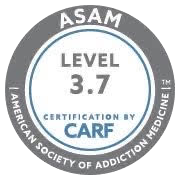Xanax is a brand-name medicine. The generic name for Xanax is alprazolam, which is a benzodiazepine. Benzodiazepines or benzos are a drug class prescribed for panic and anxiety disorders, as well as insomnia and sometimes alcohol withdrawal symptoms. While there are medical uses for Xanax, it can also lead to addiction and dependence.
Even within the boundaries of prescribed use, both addiction and dependence can occur. Xanax withdrawal symptoms can happen once someone is physically dependent. These symptoms can be severe or even, in rare cases, life-threatening. It’s critical to seek medical supervision and to taper off Xanax carefully to minimize the risk of withdrawal complications.
How Xanax Works
When someone takes Xanax, it works similarly to other benzodiazepines. It enhances the effects of a brain neurotransmitter called gamma-aminobutyric acid or GABA. The neurotransmitter produces a calming effect in the central nervous system. The effect helps reduce anxiety and promote relaxation. Xanax can be a potent medication, and while it does provide short-term relief for specific symptoms, long-term use is often discouraged. Specifics of how Xanax works include:- Xanax binds to receptors in the brain known as GABA-A receptors. Doing so increases the efficiency of GABA, leading to increased neuronal activity and reduced anxiety. There’s an overall calming effect on the brain.
- Since Xanax enhances GABA activity, it dampens excessive neuron firing that’s associated with anxiety, alleviating worry, tension, and restlessness.
- The effects on GABA receptors also lead to sedation and muscle relaxation, which is part of why Xanax is often prescribed to treat panic attacks or acute anxiety.
- Side effects that can occur along with desired effects include drowsiness, impaired coordination, confusion, and memory impairment.
Xanax Dependence
If your body becomes accustomed to the presence of Xanax, it may start functioning normally only when it’s used. Dependence usually occurs with consistent, long-term Xanax use. The initial phase of dependence is tolerance, so higher doses become necessary to achieve the same effects first experienced with lower doses. Then, there’s something called neuroadaptation that can occur. The brain changes in response to Xanax. Over time, it becomes less responsive to the effects of the drug, leading to higher doses being required for the desired effects. The brain’s chemistry adapts to Xanax, and it may start relying on it to maintain standard functionality. Then, if you stop using Xanax suddenly or cut back on your doses too rapidly, you may have symptoms of withdrawal.Symptoms of Xanax Withdrawal
Xanax withdrawal symptoms can be severe and possibly dangerous. They occur because of a sudden imbalance in neurotransmitters and the activity of the central nervous system. These symptoms can include:- Rebound anxiety, meaning anxiety symptoms return and sometimes are even worse than they were initially. This may have been the condition Xanax was originally prescribed to treat.
- Insomnia and dysregulated sleep patterns.
- Restlessness, irritability, or agitation, all of which can be intense.
- Tremors, including trembling or shaking, especially in the hands.
- Aches, pains, muscle stiffness, and tension.
- In severe cases, seizures can occur and be life-threatening.
The Risks of Cold Turkey Xanax Withdrawal
The primary danger of cold turkey Xanax withdrawal stems from severe symptoms. Xanax has a relatively short half-life, so it’s quickly eliminated from the body. If a person stops taking it abruptly and there is a sudden drop in the drug levels in the body, withdrawal symptoms can be triggered, manifesting quickly and intensely. Rebound anxiety can occur, which is distressing and overwhelming for some people, and cold turkey withdrawal can also lead to serious psychological symptoms. The symptoms can be severe enough that they interfere with standard functionality. Medical complications can occur, like high blood pressure, elevated heart rate, and dehydration.Tapering Off Xanax
When you taper off Xanax, you gradually reduce your medicine doses over some time. Tapering off gives your body the chance to adjust to lower drug levels, minimizing withdrawal symptoms and the risk of complications. The process of tapering off Xanax is usually done under the guidance and supervision of a medical professional. When you work with a healthcare provider throughout the tapering process, they can create a personalized schedule based on the dosage you usually use, duration of use, medical history, and overall health. Tapering involves a slow reduction of the Xanax dosage over time, with the rate of tapering done over weeks or months for a gradual adjustment. In some cases, a healthcare provider could switch you from Xanax to a longer-acting drug from the same class, like diazepam. Diazepam has a longer half-life, making tapering more manageable because of the smoother, more gradual drop in blood levels. A medical professional or detox team should monitor you for symptoms or adverse effects throughout the tapering process. Your tapering schedule might be adjusted based on how you respond. Some of the most effective strategies include:- Therapy. Therapy can be helpful as you go through Xanax withdrawal to address underlying psychological factors that contributed to dependence on the medicine in the first place. For example, you might participate in cognitive behavioral therapy (CBT) and other therapy approaches to help you learn strategies and coping skills to manage anxiety without benzodiazepines.
- Support groups. These groups can provide you with encouragement and peer support. You can talk to other people and hear their experiences about successfully tapering off Xanax, giving you a sense of motivation and hope during withdrawal.
- Lifestyle Changes. Healthy lifestyle habits like a nutritious, balanced diet, getting plenty of sleep, practicing stress-reduction techniques like mindfulness or meditation, and regular exercise are also strategies for Xanax withdrawal. These are ways to help support your overall well-being.



